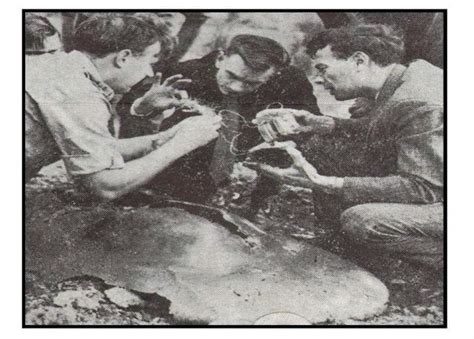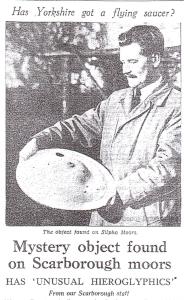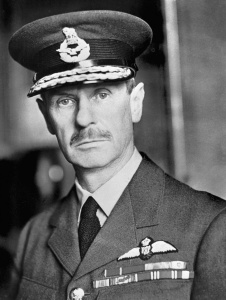By Charles Lear
 In 1957, the same year the Soviets launched Sputnik, British authorities, media, and citizenry had their attention drawn back down to Earth as they attempted to unravel the mystery of a flying saucer said to have been found laying in a moor. It was dismantled, studied, and opinions were divided between its having come from space and its having been manufactured right here on Earth. Over time, the saucer went missing, but the mystery as to its origin remained. Then, in 2018, pieces of the saucer and its mysterious contents were found in the archives of the Science Museum in London.
In 1957, the same year the Soviets launched Sputnik, British authorities, media, and citizenry had their attention drawn back down to Earth as they attempted to unravel the mystery of a flying saucer said to have been found laying in a moor. It was dismantled, studied, and opinions were divided between its having come from space and its having been manufactured right here on Earth. Over time, the saucer went missing, but the mystery as to its origin remained. Then, in 2018, pieces of the saucer and its mysterious contents were found in the archives of the Science Museum in London.
The case was first reported in the December 9, 1957 Yorkshire Post in an article headlined “Mystery Object Found on Scarborough Moors” with the sub-headline “Has Unusual Hieroglyphics.” It was written about in detail in the March-April 1958 issue of Flying Saucer Review.
According to the Flying Saucer Review article headlined “The Silpho Moor Mystery,” a man “who writes under the pen name Antony Avendel” had examined an object discovered lying in Silpho Moor near Scarborough. The object is described as being shaped like a top, weighing 35 pounds, having a diameter of 18 inches, and having hieroglyphics on its outside. It was made of a double skin of 3/16” copper. A “burnt powdery substance” was found inside along with a copper book rolled up and inserted into a coil of copper tubing. The book was made of 17 copper sheets containing over 2000 words “engraved in phonetic-type symbols.”
Avendel got the object from the men who first spotted it. On November 21, 1957 (date from follow-up article in the Nov.-Dec. 1958 Flying Saucer Review), Frank Hutton, Charles Thomas, and Fred Taylor were in a car driving along Silpho Moor. They were going up a steep hill when the car engine quit. Above some trees they saw a glowing object that seemed to be falling to Earth. Hutton (a passenger) left the car to investigate, located the object “in some bracken,” and went back to tell the others. As he was walking, he passed a man and a woman walking in the opposite direction on the “little used path.” When Hutton and the other men returned to the spot, the object was gone.
 According to the article: “After apparently making enquiries they got in touch with the man that Mr. Hutton had seen with the woman. There was quite a little bargaining and eventually the object was passed over to them for £10.”
According to the article: “After apparently making enquiries they got in touch with the man that Mr. Hutton had seen with the woman. There was quite a little bargaining and eventually the object was passed over to them for £10.”
Hutton took the object to Avendel, thinking him to be an authority on flying saucers. Avendel agreed to examine it and advise Hutton on whether or not he should turn it over to authorities.
After examining the object, Avendel spoke to the press. He said the base was made of copper and that he cut out a small circle for analysis. The upper half was covered in a white plastic paint. He looked for Army markings but found none.
Avendel reported that he went to the moor and found no impression where the object was said to have landed, but he did find scorched heather. He said there were two vent holes in the top with scorch marks around them and that there was a shaft that ran through the middle.
According to Avendel, the hieroglyphics on the outside were the key to deciphering the message in the copper book. The message was deciphered and transcribed by P. Longbottom who put in over 100 hours of work.
According to Longbottom, the message on the outside read: “Friends. Message inside to be dealt with by philosophers not officials. Good wishes, Ulo.”
The message in the book started with: “Friends. My name is Ulo, and I write this message to you, my friends on the planet you call Earth.” It goes on to say we are a “fierce race,” that no one from another planet has ever landed on Earth, and that radio waves are impossible to receive over long distances “owing to natural waves in space” unless specific frequencies are used. The rest of the message was similar to those purportedly given to contactees of the era from the likes of Ashtar and Orthon urging us to learn to live in peace and not blow ourselves up with atomic weapons. The full text can be read in the above-mentioned follow-up article, which was written by Longbottom.
According to the article in the March-April issue, J. Dale, a Flying Saucer Review investigator and president of the Manchester Flying Saucer Research Society, journeyed to Scarborough to inspect the saucer and it was “understood” that he believed it came from space. Mr. Rush, another Flying Saucer Review investigator and member of the Teaside UFO Research Society of Middlewood, went to take a look at the object with members of the Society and it was the group’s opinion that the object was part of a hoax.

The saucer went missing after reportedly being displayed in a fish and chips shop, but researcher Dr. David Clarke stumbled upon pieces of it after giving a lecture at the Science Museum in 2018. He wrote about it in his blog posting titled “Yorkshire UFO crash mystery solved – after 60 years.”
Clarke’s posting contains new details, including: Charles Thomas’s real name, Frank Dickenson; Antony Avendel’s real name, Anthony Parker; that the man who was seen on the path was found after he responded to an ad placed by Dickenson, and that Air Chief Marshal Lord Dowding had examined the saucer and was among those who believed that it came from space.
According to Clarke, “papers” in the Science Museum tell of the saucer remains being sent to the Museum for examination by “experts.” The remains were turned over to Gordon Claringbull, a specialist in metorites and explosives at the Natural History Museum. Claringbull was convinced that the saucer was of Earthly origin.
Clarke tells the reader that he was giving a lecture at the Science Museum on his work for the National Archives concerning the release of the Ministry of Defense’s UFO files. After the lecture, one of the staff asked him if he was aware that “‘bits of a flying saucer’ had been kept in a cigarette tin in the museum group store for decades.” When Clarke looked at the pieces, “It was obvious these were the remains of the missing Silpho Saucer . . .” Clarke talked to the press, and the story of the Silpho Saucer took on new life. Long live Ulo!
The object was so small how could it have survived in space. So small were the aliens inside the craft would have been two inches at the most in height, and the craft made out of copper I don’t think so.